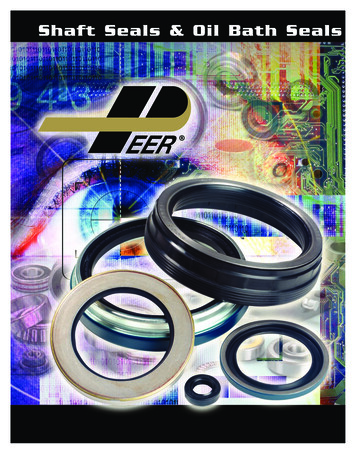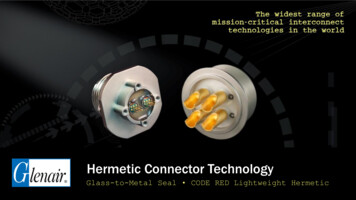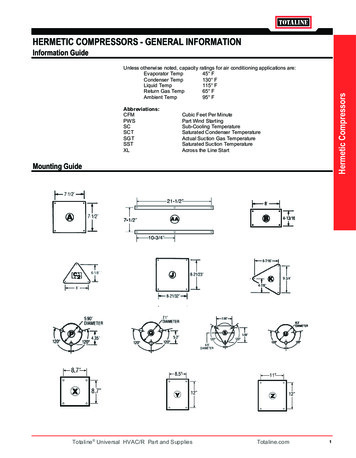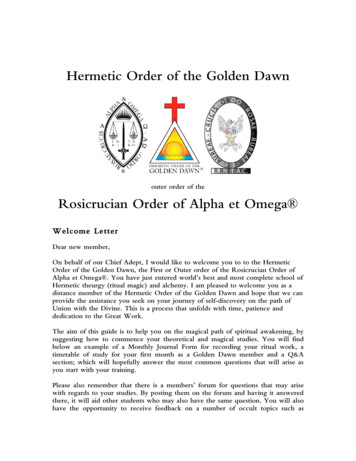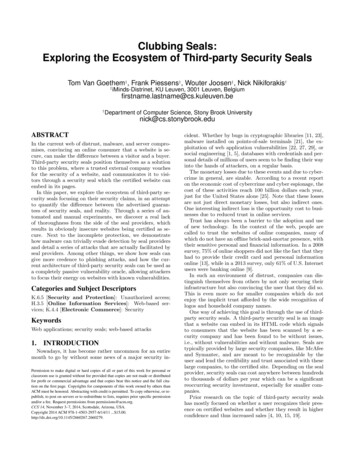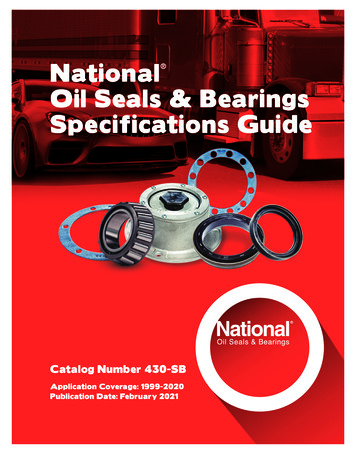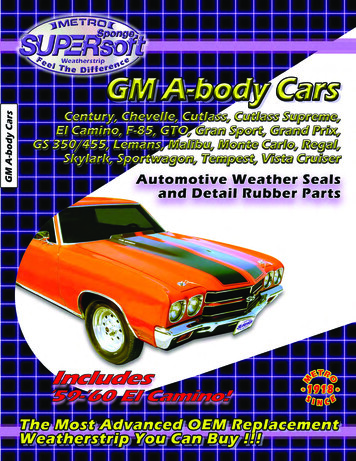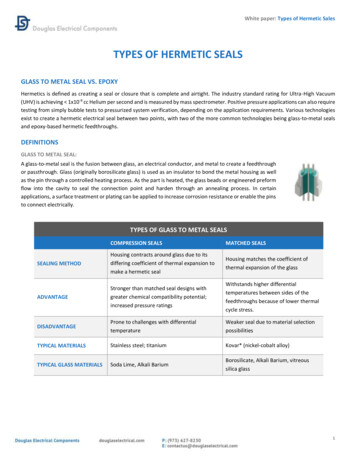
Transcription
White paper: Types of Hermetic SalesTYPES OF HERMETIC SEALSGLASS TO METAL SEAL VS. EPOXYHermetics is defined as creating a seal or closure that is complete and airtight. The industry standard rating for Ultra-High Vacuum(UHV) is achieving 1x10-9 cc Helium per second and is measured by mass spectrometer. Positive pressure applications can also requiretesting from simply bubble tests to pressurized system verification, depending on the application requirements. Various technologiesexist to create a hermetic electrical seal between two points, with two of the more common technologies being glass-to-metal sealsand epoxy-based hermetic feedthroughs.DEFINITIONSGLASS TO METAL SEAL:A glass-to-metal seal is the fusion between glass, an electrical conductor, and metal to create a feedthroughor passthrough. Glass (originally borosilicate glass) is used as an insulator to bond the metal housing as wellas the pin through a controlled heating process. As the part is heated, the glass beads or engineered preformflow into the cavity to seal the connection point and harden through an annealing process. In certainapplications, a surface treatment or plating can be applied to increase corrosion resistance or enable the pinsto connect electrically.TYPES OF GLASS TO METAL SEALSCOMPRESSION SEALSMATCHED SEALSSEALING METHODHousing contracts around glass due to itsdiffering coefficient of thermal expansion tomake a hermetic sealHousing matches the coefficient ofthermal expansion of the glassADVANTAGEStronger than matched seal designs withgreater chemical compatibility potential;increased pressure ratingsWithstands higher differentialtemperatures between sides of thefeedthroughs because of lower thermalcycle stress.DISADVANTAGEProne to challenges with differentialtemperatureWeaker seal due to material selectionpossibilitiesTYPICAL MATERIALSStainless steel; titaniumKovar* (nickel-cobalt alloy)TYPICAL GLASS MATERIALSSoda Lime, Alkali BariumBorosilicate, Alkali Barium, vitreoussilica glass1
White paper: Types of Hermetic SalesHERMETIC EPOXY:Hermetic sealing combines epoxy resin and a housing material such as stainless steel toencapsulate an electrical conductor such as a pin, stranded wire, or threaded stud. Theconductor feeds through the opening with the epoxy curing through a thermal cyclingprocess to create a hermetic seal.Various types of epoxies can be used, which can yield varying results in hermeticperformance, chemical compatibility, and outgassing. Douglas Electrical employs a lowoutgassing material which is NASA certified low outgassing epoxy tested per ASTM E-59593 (0.33% TML. 0.00% CVCM).DOUGLAS ELECTRICAL COMPONENTS EPOXY CHARACTERISTICSSIGNAL DENSITYMIX OF CONDUCTOR TYPESFor applications needing to pass a significant number ofconductors through a small port, no technology is as effectiveas epoxy seals. Whether sealing wires, cables, fiber optics,circuit boards or other conductor types, epoxy seals allow forthe utmost signal density. Conductor-to-conductor spacing canbe quite minimal in comparison with glass to metal seals,which need much greater conductor-to-conductor spacing forseveral reasons including di-electric/hi-pot, tooling, and forassembly/making connections.While glass to metal vendors can offer designs with varyingAWG contacts, any customization typically results in long leadtimes, and high tooling costs. Epoxy seals allow for not only themix and matching of different wire AWGs, but varying cabletypes including those with shields, and fiber optics and coppertogether in a single penetration. Essentially, the options arelimitless. For more information on wire density, download thewhite paper, When Sealed Wire Feedthroughs Make Sense.VACUUM OUTGASSING25mm2 x 1mm sample at 125 C vs optical condensing surface at 25 C, 1 x 10-6 mm HgRESULTS: 0.22% Wt Loss and 0.002% VCM. No visible deposits on the condensing plate.THERMAL CONDUCTIVITY10 BTU in/hr ft 2 FVOLUME RESISTIVITY5x1016 Ω cmSPECIFIC GRAVITY2.3DIELECTRIC CONSTANT60 Hz 6.5, 1 KHz 6.3, 1 MHz 5.9THERMAL EXPANSION29 X 10-6/ CMAXIMUM SERVICETEMPERATURE OF EPOXY350 F (176 C)WATER ABSORPTION 0.15% in 7 daysDIELECTRIC STRENGTH550v/milWATER VAPOR TRANSMISSION(PER ASTM E-96-80)0.7 0.2 gms/m2 day, 0.125 mil sample thicknessFLAME RESISTANCEUL File No. E92366 rated UL-94HBL.O.C.A. RADIATIONWITHSTAND@ 1.5 x 106 Rads/hr for 200 x 106 Rads total. Leakage to He 3.0 x 10-8 Std cc He/sec, Pin-Pinresistance 1x1012Ω2
White paper: Types of Hermetic SalesMATERIAL AND COEFFICIENT OF THERMAL EXPANSIONThe coefficient of thermal expansion refers to the rate at which a given material will change in shape or size relative to changes intemperature; it is calculated by measuring the relative expansion of a material over the temperature. In hermetic connectors andfeedthroughs, this becomes important when multiple materials are being used to create the seal and more critical when theenvironment experiences extreme temperatures or temperature variations.In glass-to-metal seals, the matching of the coefficient becomes more critical for both the manufacturing process as well as the endapplication. Typically, the body must be made of steel or nickel alloy, with the conductors being an alloy; glass does not bond well tocopper. During the production of the seal, a thermal cycle process flows the glass to create a bond between the housing, glass, andterminal. If the materials are expanding (or contracting during cooling) at different temperatures, this can impact the hermetic andelectrical performance.Douglas has engineered solutions to thermal coefficient of expansionmismatches across a variety of materials while maintaining fullhermetic performance. Many epoxy seals also utilize a thermal cycleduring the manufacturing process. With a thermal expansioncoefficient of our standard seal material of 29 X 10-6/ C, DouglasElectrical Components can match this epoxy to a variety of materialsfor both the housing as well as the feedthrough. The epoxy flowswithin the manufacturing process to fully bond to the materials andcreate a hermetic seal from cryogenic to relatively high temperatureapplications.Epoxy is commonly used to manufacture hermetic seals usingstandard commercial-off-the-shelf (COTS) non-hermetic connectors.“Back-potting” seals non-hermetic electrical connections to hermeticratings. Being able to bond to both metal and plastic connectors,engineers can design non-hermetic plastic connectors into hermeticapplications with the use of epoxy.Epoxy can decrease the cost per connector by creatinghermetic connections using standard commercial off theshelf plastic or metal connectors.TYPES OF MATERIALS EXPOXIES CAN BOND TO Virtually all metals including stainless steel, brass,aluminum, and titanium Plastics Glass Optical patch cables Printed Circuit Boards (PCB’s) Power Studs / Bus bars And moreMATERIALS BONDS BY HERMETIC SEALMATERIAL TYPEGLASS-TO-METALEPOXYStainless Steel, Nickelalloys, TitaniumBrass, AluminumPlasticGlassBecause the epoxy can flow directly into the electrical connection,tooling setup is minimal. Being in business for over 75 years, DouglasOptical Patch Cablesalso benefits from decades of tooling set ups and fixture creations.Douglas is also an expert in turnkey cable assembly manufacturing.Printed Circuit BoardsEpoxy creates the flexibility to convert non-hermetic commercial offPower Studs / Bus barsthe-shelf (COTS) connectors into hermetic solutions. This satisfiescustomers in the prototype stage to full production volumes. Whileglass-to-metal seals are a standalone item, Douglas ElectricalComponents manufactures epoxy feedthroughs directly into cable harnesses and value-add assemblies with wires and cables. This cansimplify the end user installation and reduce vendor count with the confidence a single purchased item will meet application needs.Douglas designs are routinely pre-wired, terminated, tested, and ready for install at the customer site. With glass to metal seals,traditionally the customer is simply buying a weld-in or threaded body with pins sealed through it. This means that the end user takeson the extra burden of fabricating or buying mating harnesses and making the connection to the feedthrough (often a cumbersomesoldering process). End-users also would bear the cost of added skilled labor, tooling, and quality measures to ensure the harnessmeets the application requirements. Epoxy will also bond to various cable materials. While certain cable and wire jackets require3
White paper: Types of Hermetic Salesadditional processing to create a hermetic seal, wire feedthroughs directly feed the wire or cable into the assembly. In applicationswhere a liquid or gas is present, the protection of the wire over the electrical connection extends beyond the feedthrough itself.OPERATING ENVIRONMENTBoth pressure and temperature operating conditions can influence the type of hermetic seal selected. Both glass-to-metal seals andhermetic epoxy are designed to operate in ultra-high vacuums. While epoxy will operate up to approximately 15,000 PSI(approximately 1,000 bar), glass-to-metal technology can exceed 30,000 PSI (approximately 2,000 bar). Performance within thestandard operating pressure of epoxy seals is the equivalent performance to glass to metal seals.The temperature extremes as well as differential temperature can have an effect. Each technology has suitable designs for low endtemperature ranges for cryogenic gases. GTM tends to operate at higher standard temperature ranges, yet again the performancewithin epoxy’s standard range is equivalent. As mentioned earlier, the glass sealing method will influence the technology chosen, as amatched seal will outperform a compression seal if there is a difference in temperature between the sides of the feedthrough.Chemical compatibility is an interesting topic. While glass itself offers a wide range of chemical compatibility, the pins or feedthroughscan limit the technology. For epoxy seals, design engineers need to consider the compatibility of the epoxy selected, yet thefeedthrough itself can either be a special cable material or virtually any conductor material.4
White paper: Types of Hermetic SalesCONCLUSIONBoth glass-to-metal seals and epoxy seals have their purpose andadvantages. Each can provide a robust solution to hermeticallyseal against liquids and gases. While various environmental andoperational factors influence which type of hermetic seal issuitable, the application, will ultimately dictate the most valuableseal technology.Epoxy seals give engineers the design flexibility toincorporate a hermetic feedthrough or seal intovarious applications, production volumes, andconfigurations.ABOUT DOUGLAS ELECTRICAL COMPONENTSFor over 75 years, Douglas Electrical Components hasprovided fiberoptic, signal and power interconnect solutionsdesigned to meet the challenging demands of gloveboxes,medical equipment, semiconductor manufacturing, spacesimulation, military, vacuum systems, electrical distribution,hazardous locations and more. From sealed connectors andhermetic wires feedthroughs to pin headers and electronicsencapsulation, we look forward to new opportunities wherewe can push our boundaries even further to meet yourunique application needs.CONTACTContact Douglas Electrical Components today with yourrequirements for a hermetic seal. We employ technicalsales engineers to partner with you to design a solutionfor your sealing requirements.DOUGLAS ELECTRICAL COMPONENTS, INC.Phone: 1 (973) 627-8230Email: contactus@douglaselectrical.comWeb: https://www.douglaselectrical.com*Kovar is a registered trademark of CRS Holdings, Inc., a subsidiary of Carpenter Technology Corp.5
A glass-to-metal seal is the fusion between glass, an electrical conductor, and metal to create a feedthrough or passthrough. Glass (originally borosilicate glass) is used as an insulator to bond the metal housing as well . For epoxy seals, design engineers need to consider the compatibility of the epoxy selected, yet the feedthrough itself .

